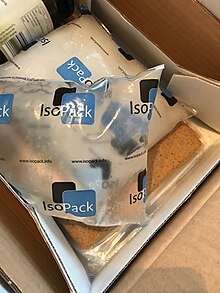Cold pack
A cold pack or cooling element is a plastic container that contains a liquid that changes phases when it cools down ( latent heat storage ).
Cold packs are used to temporarily cool drinks, medicines or food. For this purpose, the container is first cooled down in a refrigerator or in a freezer. Then you can put it together with the goods to be cooled in a cool box or insulating packaging.
In principle, frozen plastic bottles filled with water, for example, can also be used as cold packs - they are usually not destroyed when they freeze .
Types of cold packs
Basically, a distinction is made between disposable and reusable cold packs.
Disposable ice packs
Disposable ice packs are usually used by mail order companies to ensure an uninterrupted cold chain when sending temperature-sensitive goods by post. The disposable cold packs mostly consist of PE foils into which the appropriate cooling liquid has been previously welded. The type of coolant depends on the desired temperature control.
Reusable ice packs
In contrast to the disposable cold pack, a reusable cold pack is a plastic container that can be filled with coolant through a screw cap. This has the advantage that the battery can be filled with various coolants or else emptied for transport.
Coolant used
Different coolants are used depending on the desired temperature control and the type of cooling battery. The following parameters are particularly important here
Phase transition
The temperature of the phase transition (i.e. where the cold pack changes from solid to liquid) is usually adjusted to the target temperature of the product to be cooled. As a result, the cold pack is below the target temperature of the product to be cooled until it is completely thawed. In practice, this means that the phase transition of ice packs when shipping frozen is around −18 ° C, so that this is not exceeded until the goods are completely thawed. This is achieved by adding antifreeze or table salt. The phase change can be recognized by the fact that the cold pack is hard and thick when it has been “charged” (ie cooled).
consistency
Depending on the stability of the ice pack, the cooling liquid should have a more or less firm consistency. For example, polyacrylic gel is mostly used in disposable cold packs to prevent the batteries from tearing. Reusable batteries can also be filled with water due to their greater strength.
Other ingredients
A preservative is also added to the coolant to prevent it from rotting.
See also
Individual evidence
- ↑ Information on the phase change of the cold pack. Retrieved March 7, 2018 .
- ↑ Information from a cold pack manufacturer on the ingredients used. Retrieved March 7, 2018 .

